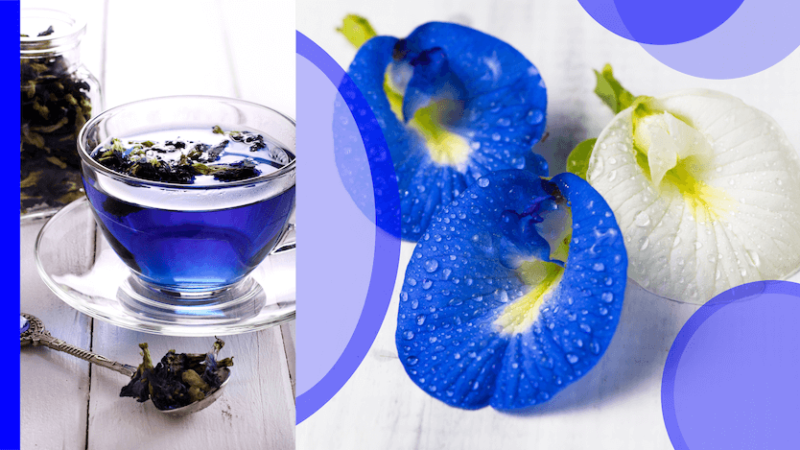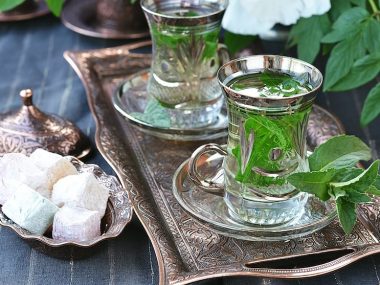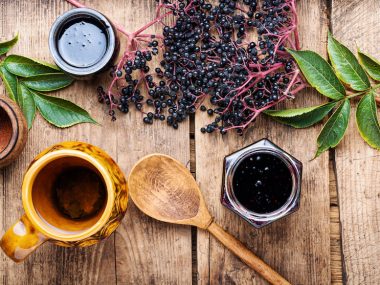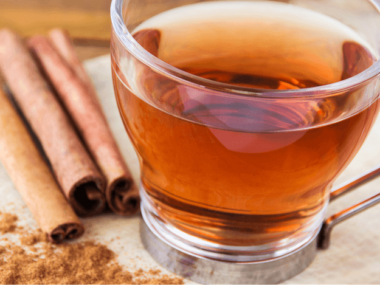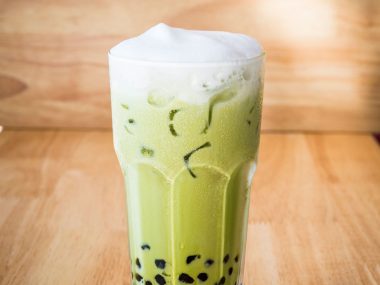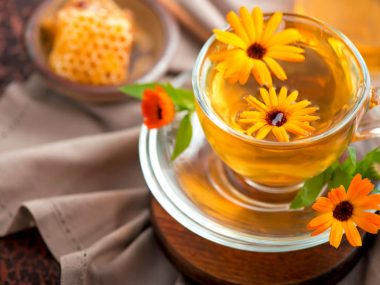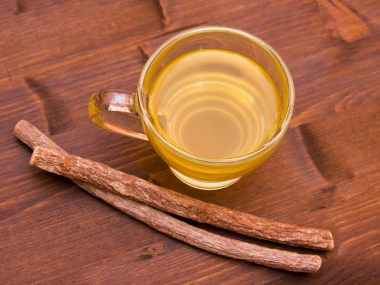If there ever were a tea that will make you blush, this is definitely the one! Aside from the blushing, you’ll be amazed at how mesmerizing Butterfly Pea Flower Tea is as soon as the water is added. Many describe this beverage as a “mood ring” in a cup but beware, this tea’s beauty may be hiding something!
Table of Contents
What Is Butterfly Pea Flower Tea?
Butterfly Pea Flower Tea is an herbal tea derived from the Clitoria ternatea plant’s blossoms. This vining plant is native to Africa, East Asia and is distributed in parts of the U.S. (California, Texas, Georgia, and Florida.) The genus “Clitoria” references the intimate part of a female.
The flowers of this plant are used as a dye for fabrics, coloring for cosmetics, and foods throughout Asia. They are also used to make tea.
Tea made from the Butterfly Pea flowers is not a true tea but what’s known as a “tisane.” Tisanes are herbal tea infusions. In Asia, this beverage is referred to as “Asian Pigeonwings” or “Blue Tea.”
As the tea brews, the water begins to turn into various colors of vibrant blues. Once the blue tea is poured into a cup, adding a few drops of lemon juice changes it into different shades of pinks. Going further, adding a slice of lemon makes this tea turn purple. A few hibiscus leaves take it right over the edge with a vibrant red.
The taste profile of the tea is not what you would expect. The colors tend to trick the mind into expecting a fruity aroma and flavor. However, your palette will be met with vegetal, earthy, woody, and grassy flavors. Adding a bit of honey to sweeten the tea elevates it with a smoother, sweeter taste. You can get creative with the flavor dimension by adding spices or blends of fruity teas.
A Longstanding Tradition In Asia
The Butterfly Pea flowers are used to create various dishes in Southeast Asia. Malaysians have a staple dish of gelatinous rice that’s indigo blue from incorporating the flowers while boiling the rice.
In Thailand, they enjoy a coconut-milk-based beverage called “Nam Dok Anchan,” which is colored from the blue pigment of the Butterfly Pea flower. In Laos, “blue” products (sake, chocolate, tea, candy) made from the flower have popped up in little shops and airports as souvenir items from the region.
Burma and Thailand serve Butterfly Pea flowers as a fried delicacy. The flowers are dipped in a flour batter, fried until crispy brown, and served.
What Is The Benefit Of Blue Pea Flower?
The Butterfly flower, roots, and seeds are used in Ayurvedic/Eastern medicine. The root of the plant is said to be extremely bitter and astringent. You may be surprised to hear this plant is also used to make a pesticide/insecticide.
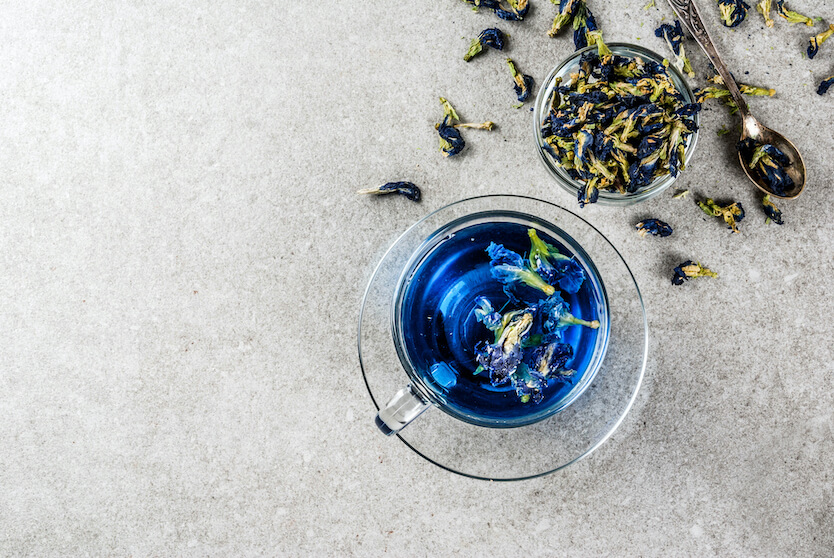
Ayurvedic and Eastern Medicine
Ayurvedic medicine is an ancient Indian practice of healing. It’s founded on writings that instruct practitioners on how to naturally treat a person from the inside out through internal purification. Various treatments may include plant-based products, eating a certain way, meditation, yoga, and practicing a healthy, active lifestyle.
Products made from the Clitoria ternatea are widely used and promoted by Ayurvedic and Eastern medicine practices because of their claims of powerful health benefits.
- Anti-inflammatory
- Anti-oxidant
- Analgesic
- Weight loss
- Reduces blood sugar
- Helps with cough
- Improves memory
- Relieves stress
- Reduces cholesterol
- Boosts immunity
Researchers have studied the effects of an extract made from the Butterfly Pea plant on animals and discovered there are beneficial attributes that warrant further research. Currently, there’s a lack of scientific data on how this tea directly benefits human beings.
Pesticide
Taking the benefit of Butterfly Pea plants further, researchers discovered just how beneficial the plant compounds are to protect crops. Sero-X is an organic, eco-friendly pesticide developed from the Butterfly Pea plant. Compounds in plant extraction disrupt pests from laying eggs and/or feeding on crops. Currently, Australia is the only country approved for the use of Sero-X.
Is Butterfly Pea Flower Tea Safe?
Researchers concluded through one study that the Clitoria ternatea merits further investigation to learn more about how it benefits humans. Currently, the only scientific data available on the benefits and side effects are from animal studies.
Root extracts given in high doses to animals in a study resulted in depression of their central nervous system and profuse diarrhea. Another study reported that the use of Clitoria ternatea tea requires caution because claims of the health benefits lack the appropriate validation.
Can You Drink Butterfly Pea Tea Every Day?
We don’t have the expertise to advise whether or not this tea is safe to consume daily or not. What we can tell you is there are claims for its medicinal value that come from select groups without scientific validation with regard to human consumption. To drink or not to drink daily…the decision is all yours!
Blue Butterfly Pea Flower Tea Health Benefits
In Ayurvedic and Eastern medicine, this tea is used to treat various ailments—adequate research on how the tea benefits the health of humans has yet to be done. Current studies of the health benefits of Butterfly Pea Flower tea yield results from animal testing. There’s a lack of scientific evidence on this tea benefiting the health of humans.
Lifts Your Mood
Setting aside time to enjoy a cup of tea helps you to recharge and reconnect. The hustle of a busy day seems to stop, if only for a short time, while you purposely allow yourself to pause for tea. While any cup of tea has the power to add a few peaceful moments to our life, Butterfly Pea Flower Tea’s vibrant blue color adds a visual dimension to tea time that’s calming.
Topical Skin Enhancer
A study done indicates that as a topical cosmetic solution, the Butterfly Pea flower prevents skin irritation such as reddening or itching. The antioxidant compounds in the plant help skin retain moisture. One such compound called anthocyanin is found to reduce the look of aging skin. There are beauty products on the market containing Clitoria ternatea.
Does Butterfly Pea Tea Help You Lose Weight?
Any claims that this tea helps you lose weight are based on individual or group statements that lack scientific evidence. Again, the tea has yet to be researched on how it affects humans. It is known that research done on animals using higher doses of plant extraction caused severe diarrhea in rats which would lend to a loss in weight.
How To Make Butterfly Pea Flower Tea
We recommend that before consuming this tea, you consult with your physician, especially if you are on medications. This tea may interact with some medications.
But if your health is in check, here’s a quick brewing recipe:
- Harvest 5-10 fresh flowers from a Butterfly Pea plant. Ensure the plant is pesticide-free.
- Brew in water until it comes to a boil.
- Remove from the heat and allow to steep for 15-20 minutes.
- Strain the tea (removing the flowers) into a cup.
Your tea should be a vibrant blue. Add a few drops of lemon juice and watch as it turns color. To sweeten, add a bit of honey. Enjoy hot or over ice.
A Tea That May Sing The “Blues”
The unique color transformation of this tea is what makes it so attractive and exotic but use caution if you do enjoy a cuppa. Do a little homework and read up about the Clitoria ternatea plant and the various studies done on it and THEN decide if you want to try it or not.
The last thing you want is for a tea to be “singing the blues” in your belly!
